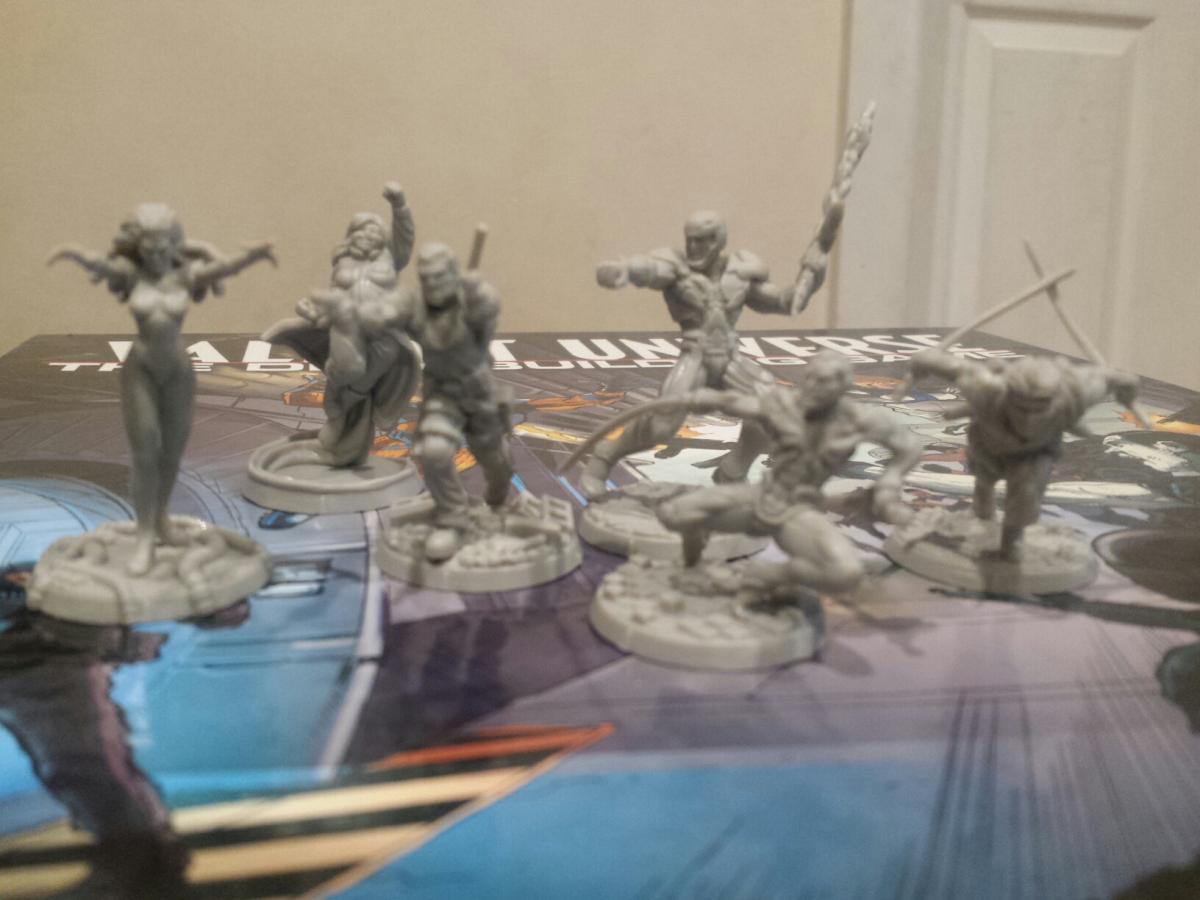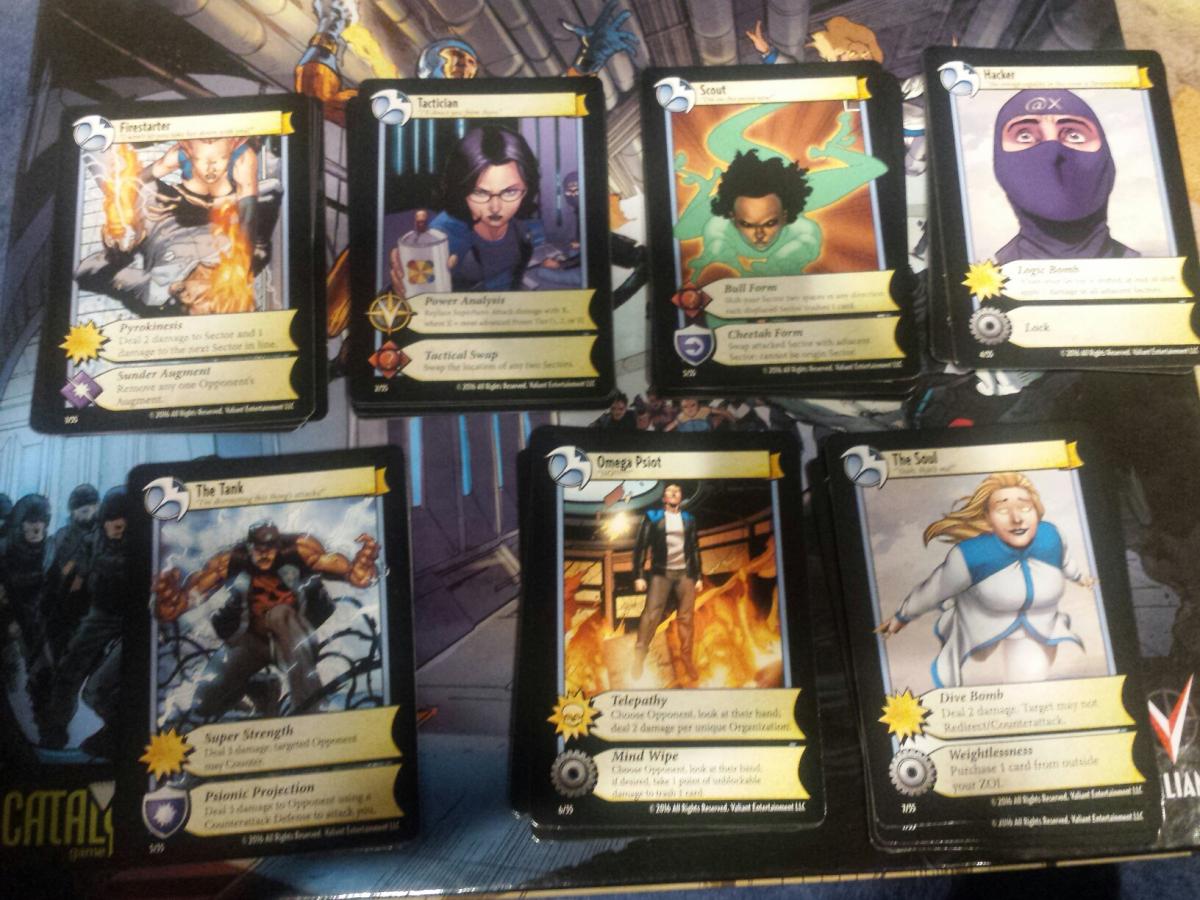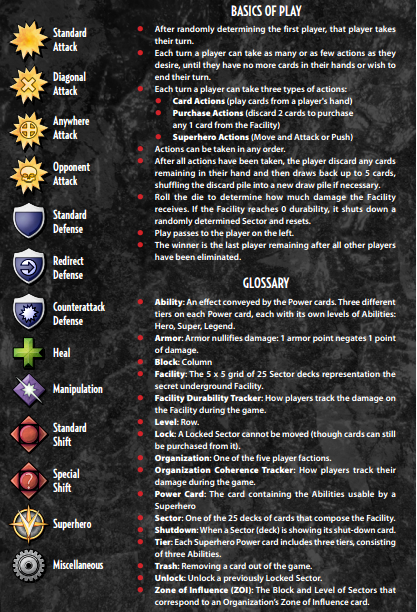First Impressions: Valiant Universe: The Deckbuilding Game
FTC Statement: Reviewers are frequently provided by the publisher/production company with a copy of the material being reviewed.The opinions published are solely those of the respective reviewers and may not reflect the opinions of CriticalBlast.com or its management.
As an Amazon Associate, we earn from qualifying purchases. (This is a legal requirement, as apparently some sites advertise for Amazon for free. Yes, that's sarcasm.)

The good people at Valiant and Catalyst were kind enough to send us a review copy of Valiant Universe: The Deckbuilding Game. I’ve been reading Valiant almost as long as I have been reading comics; since Valiant relaunched in 2012, I have not missed a single issue. Also, I really enjoy deck building games, including Legendary: A Marvel Deck Building Game and Star Realms.
Over the next few weeks, I will be doing more of a formal gameplay review once I get my gaming group together and get a few plays in, but I did want to give some of my early impressions of the game.
 Right off the bat, I noticed some immediate differences between Valiant Universe and other Deckbuilding Games I have played. The game represents the various factions of the Valiant Universe, each faction uses a specific hero with their own set of powers. Ninjak for Weaponeer, Faith for the Renegades, Livewire for Harbinger, Bloodshot for Project Rising Spirit, and X-O Manowar for GATE. This adds a very unique twist to the game.
Right off the bat, I noticed some immediate differences between Valiant Universe and other Deckbuilding Games I have played. The game represents the various factions of the Valiant Universe, each faction uses a specific hero with their own set of powers. Ninjak for Weaponeer, Faith for the Renegades, Livewire for Harbinger, Bloodshot for Project Rising Spirit, and X-O Manowar for GATE. This adds a very unique twist to the game.
The game also comes with Rai, who has his own playing piece and power card, BUT, he doesn’t have any Faction card or sphere of influence. I guess you can just take another factions, but it’s clear that Rai is a last-minute add-on as the rules don’t address him at all.
Each hero comes with their own plastic standee. These figures are pretty well made and surprisingly detailed considering how small they are. I do worry that some of the characters come with swords, which seems like they would easily get bent. But for the most part, they seem sturdy enough.
 Another thing that stood out for me is that Catalyst took the time to give each “faction’s” cards seven different art designs. In Legendary, if you are using Spider-Man as your hero, all the Spider-Man cards have the exact same art, sometimes using different backgrounds. Because of this, you can’t immediately identify what a card is just based on the art. In Valiant, you can, which is a very nice touch.
Another thing that stood out for me is that Catalyst took the time to give each “faction’s” cards seven different art designs. In Legendary, if you are using Spider-Man as your hero, all the Spider-Man cards have the exact same art, sometimes using different backgrounds. Because of this, you can’t immediately identify what a card is just based on the art. In Valiant, you can, which is a very nice touch.
I also love that each card has a choice of two different abilities. This gives some flexibility. Usually in a deck-builder, you are stuck with what you have in your hand. But between having heroes with unique powers, and some options on each card, Valiant Universe requires players to add strategy to their game beyond just buying up powerful cards and hoping you get a good draw.
Rounding out the components are a bunch of cardboard circle tokens. They are actually nice and thick, and you don’t have to worry about them getting ripped or bent up.
In terms of the game’s components, my only real complaint is the “sphere of influence” cards are way too big for any slot in the game box. They were actually bent in the box when I opened it.
Another thing about the game that I like is that they do a great job of capturing the flavor of the Valiant Universe. The game revolves around the various Valiant factions all looking to gain control of a Project Rising Spirit research installation called The Faculty. You get a lot of flavor text in the instructions explaining who each faction is. The game also comes with a guide to roleplaying in the Valiant Universe, though that seems to relate more to the Valiant Role-Playing Game than this particular game, but I still thought it was pretty cool.
The Faculty is made up of a 5 by 5 grid of small piles of cards where the players are able to buy cards in their sphere of influence (the nine spaces around their starting space) or where their character is standing. Because of this, it seems like Valiant Universe would play out like a more traditional board game, with movement around the board (though the game doesn’t actually have a traditional board, as the grid is made of card piles).
You start with some basic generic cards, and you “buy” cards into your deck by discarding two cards from your hand. In most deck building games, you need to build up resources to buy cards (usually with each player having to pick from a small shared selection of cards), which means a lot of luck goes into the game depending on what you draw. Valiant Universe: The Deck Building Game seems much more strategic with 25 cards you can choose from to build the exact deck you want, all with the same cost. It also seems like the cards are a lot more balanced, it’s not “save up for the big point card and then instant win!” Again, it seems like Catalyst wanted to put a lot of strategy elements into the game.
While, I haven’t actually played the game yet, but I did read through the instructions a few times. It’s hard to judge without actual playing, the instruction book seemed to be a bit poorly laid out. It was often hard to find what I was looking for. The game does come with reference cards, but they are pretty sparse. The back page of the instructions also gives a very quick reference guide, but most of the page is glossary. I feel like when I play the game with my friends, a lot of time will be spent flipping back through the directions.
I also expect Catalyst may have to release some additional rule clarifications. For example, one of Faith’s powers says “At any time, the player may place a card on top of the Renegades draw pile.” My immediate question was “where does that card come from?” The player’s hand? The board itself? Someplace else? It seems they tried to keep things are streamlined as possible, but at times I worry they may have gone too simple, which may create more confusion.
Again, these are first impressions done without having a chance to play the game. It’s very possible these things don’t impact the game as much as I thought, but I would be remiss if I didn’t mention them as concerns.
I hope that we will see some expansions to this game soon. I loved that one of the base cards featured Quantum and Woody’s Goat. But I also want to see characters like Archer and Armstrong, Eternal Warrior, and my personal favorite, Shadowman, incorporated into future versions of the game. Plus, some Rai specific cards would enable him to fit into the game more seamlessly.
All in all, my early impressions of Valiant Universe: The Deck Building Game are favorable. It seems like a well-designed game with great components. Catalyst did not just make a cookie cutter deck building game here, Catalyst seems determined to try something new with the genre, making this game far more strategy-based than luck-based. I am very excited to give this game a thorough playtesting over the next few weeks. More to come.



